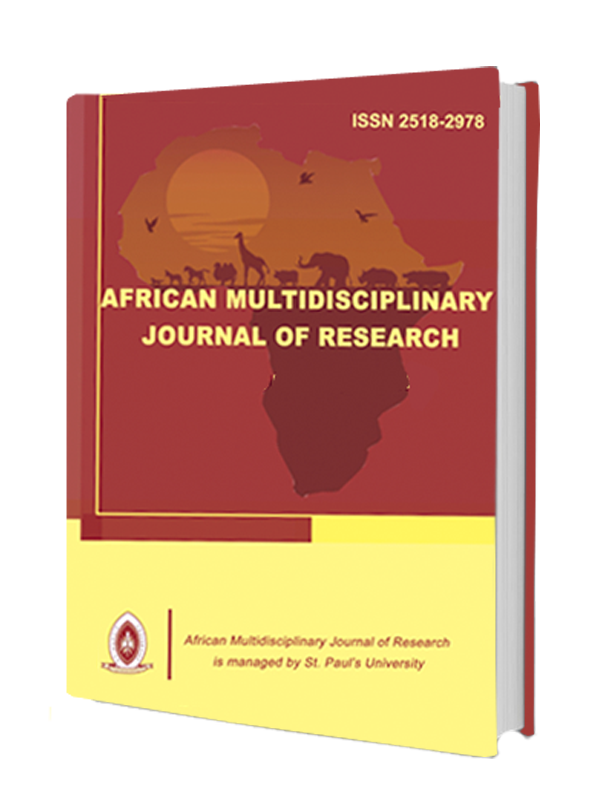Women Empowerment And Unmet Need for Family Planning in Kenya
##plugins.themes.academic_pro.article.main##
Abstract
This paper examines the association between unmet need for family planning and women’s empowerment in Kenya. The association was examined using bivariate and multivariate analysis of the 2008-2009 Kenya Demographic and Health Survey data. Logistic regression analysis was used to predict the likelihood of women experiencing unmet need for family planning when exposed to different empowerment variables. Women’s employment and mode of payment emerged as a significant predictor of unmet need after controlling for the confounding effects of all the other variables, including age, education, type of residence, region of residence, and wealth. Women who worked in the year preceding the survey but were not paid, had 37 percentlower odds for having unmet need compared with the reference group of women who did not work. Similarly, women who were paid in cash onlyas well as those who were paid in kind only or in cash and in kind had 28percent and 55percent lower odds of having unmet need respectively compared with those who did not work. Thus women’s work status isa significant factor inexplaining differences in unmet need.Experience of spousal violence emerged as a significant predictor of unmet need for family planning after removing the husband/partner control variable from the model, implying that there could exista relationship between husbands’ controlling behaviour and women’s experience of spousal violence, both factors considered in the literature as contributing to disempowerment of women.The paper recommends the need to address factors influencing access to family planning services in order to reduce current levels of unmet need. At programme level, the study also recommends formation and/or strengthening of programmes focusing on women’s empowerment.
Key words: Kenya Women’s Empowerment; Reproductive Health; Unmet Need For Family;
Women Employemnt Status; Women Decision Making
##plugins.themes.academic_pro.article.details##
References
- Al-Riyami, A., Afifi, M.&Mabry, R.(2004).Women’s Autonomy, Education and Employment in Oman and Their Influence on Contraceptive Use.Reproductive Health Matters,12(23), 144 – 154.
- Al-Riyami, A.,&Afifi, M..(2003). Determinants of Women’s Fertility in Oman.Saudi Medical Journal, 24(7), 748-753.
- Ashford, L.,&Noble, J.(1996).Population Policy: Consensus and Challenges.
- Consequences,2(2).Washington, DC: US Global Change Information Office.
- Bradley, S. E. K., Croft, T. N., Fishel, J. D., &Westoff,C. F.(2012). Revising Unmet Need for Family Planning.DHS Analytical Studies 25, Calverton, Maryland, USA: ICF International.https://dhsprogram.com/pubs/pdf/AS25/AS25%5B12June2012%5D.pdf
- Casterline, J.,&Sinding, S.(2000). Unmet Need for Family Planning in Developing Countries and Implications for Population Policy.Population and Development Review, 25(4),91
- -723.
- Desai, S., and Johnson, K. (2005). Women’s Decision-making and Child Health: Familial and Social Hierarchies:A Focus on Gender.Collected papers on Gender using DHS Data. Calverton, Maryland, USA: ORC Macro.
- Dharmalingam, A., & Morgan, P.S. (1996). Women's work, autonomy, and birth control: evidence from two South India villages. Population Studies, 50(2), 187-201.
- Ferdousi, S., M. Jabbar, S.Hoque, S. Karim, A.Mahmood, R. Ara, and N. Khan. 2010.
- ―Unmet Need of Family Planning among Rural Women in Bangladesh.” J Dhaka MedColl 19(1): 11-15.
- Hailmarium, A.,&Haddis, F. (2011).Factors Affecting Unmet Need for Family Planning in Southern Nations, Nationalities and Peoples Region, Ethiopia.Ethiopian Journal for Health Science,21(2): 77 – 89.
- Hou, X.,& Ma, N.(2011). Empowering Women: The Effect of Women's Decision-making Power on Reproductive Health Services Uptake: Evidence from Pakistan. Working Papers and Research Publications. Washington, DC: The World Bank.
- Kabeer, N. (1999).Resources, Agency, Achievements: Reflections on the Measurement of Women's Empowerment.Development and Change, 30(3): 436–464.
- Kenya National Bureau of Statistics (KNBS) and ICF Macro.(2010). Kenya Demographic and Health Survey 2008-09. Calverton, Maryland: KNBS and ICF Macro.
- Korra, A. (2002). Attitudes toward Family Planning and Reasons for Non-use among Women with Unmet Need for Family Planning in Ethiopia.Calverton, Maryland USA: ORC Macro.
- Malhotra, A. (2003).Conceptualizingand Measuring Women’s Empowerment as a Variable in International Development. Paper presented at the Workshop on “Measuring Empowerment: Cross-Disciplinary Perspectives” held at the World Bank, Washington, DC, on February 4 and 5, 2003.
- Maki, S. (2012).Unmet Need for Family Planning Persists in Developing Countries.Population Reference
- Bureau.http://www.prb.org/Articles/2007/UnmetNeed.aspx.
- National Coordinating Agency for Population and Development (NCAPD).(2010). Fulfilling Unmet Need for Family Planning Can Help Kenya Achieve Vision 2030. NCAPD Policy Brief No. 13.p.2.
- Ndaruhuye ,D., Broekhuis, A. &Hooimeijer, P. (2009). Demand and Unmet Need for Means of Family Limitation in Rwanda.International Perspectives on Sexual and Reproductive Health,35(3), 122-130. Doi: 10.1363/3512209.
- Ojakaa, D. (2008). Trends and Determinants of Unmet Need for Family Planning.DHS Working Papers No. 56. Calverton, MD: Macro International, Inc.
- United Nations Population Fund (UNFPA). (2012). Gender Equality: Empowering Women.
- Retrieved from http://www.unfpa.org/gender/empowerment.htm
- United Nations.(2011). World Contraceptive Use 2010. Department of Economic and Social Affairs, Population Division.Retrieved from www.un.org/esa/population/publications/wcu2010/Main.html
- Woldemicael, G., and Beaujot, R. (2011).Currently Married Women with an Unmet Need forContraception in Eritrea: Profile and Determinants. Canadian Studies in Population, 38 (1–2):61–81.
- World Economic Forum.(2005). Women’s Empowerment: Measuring the Global Gender Gap. Geneva, Switzerland: World Economic Forum.

